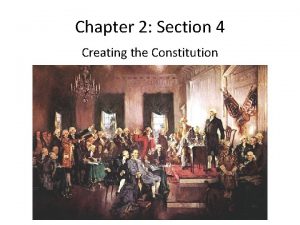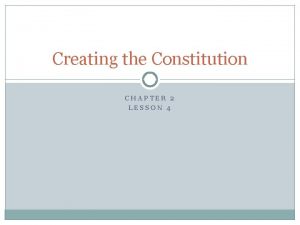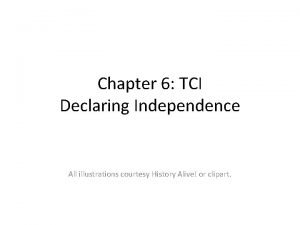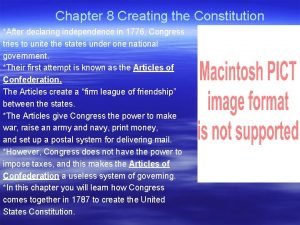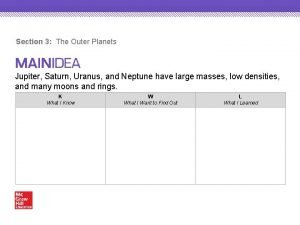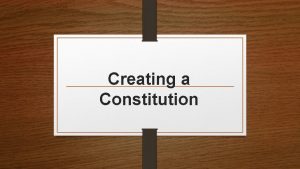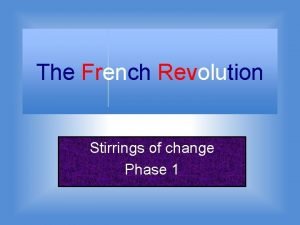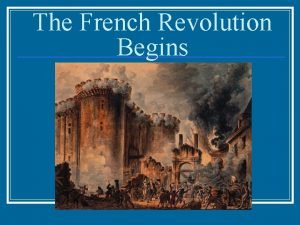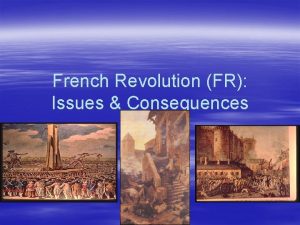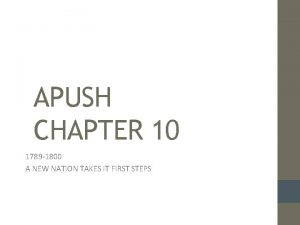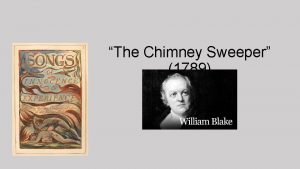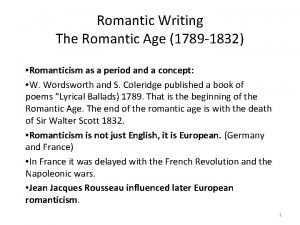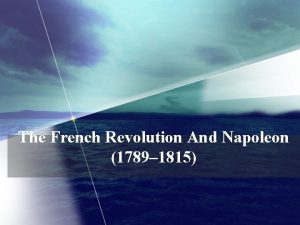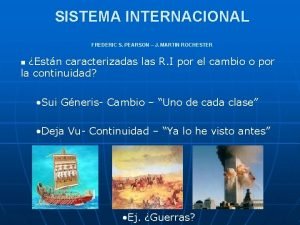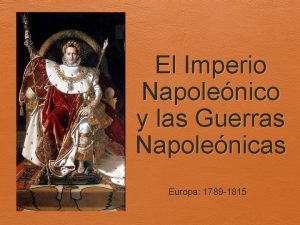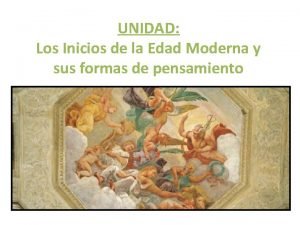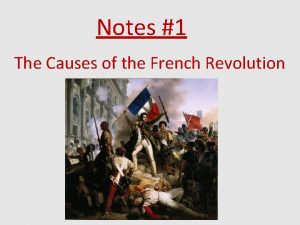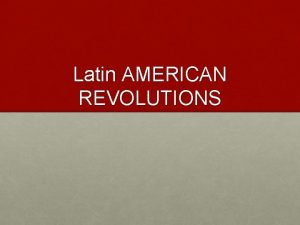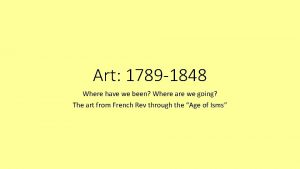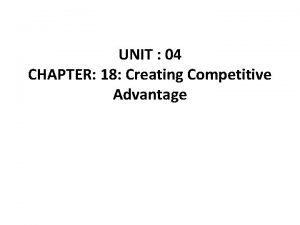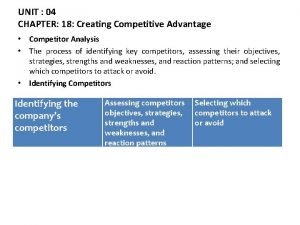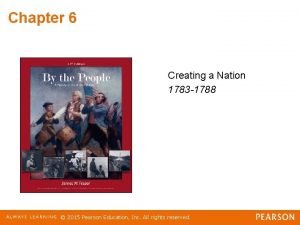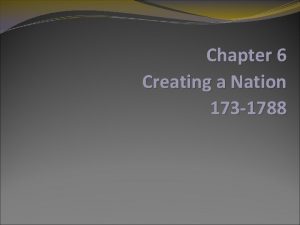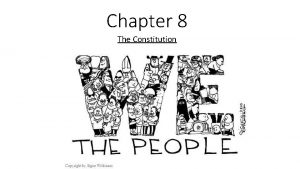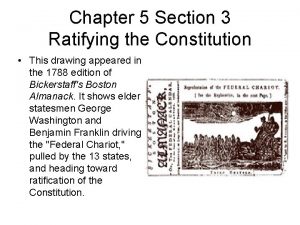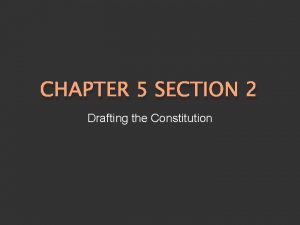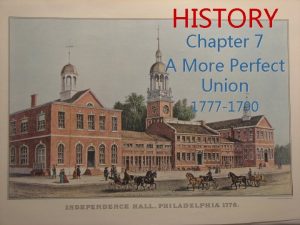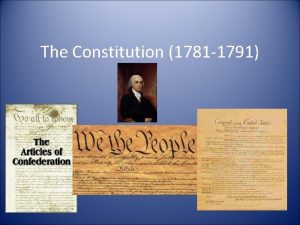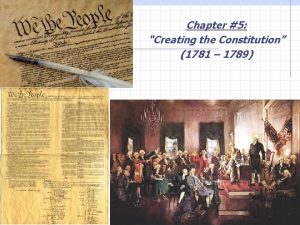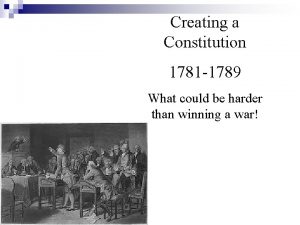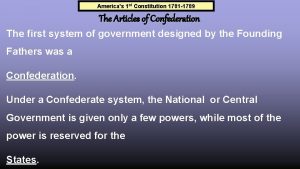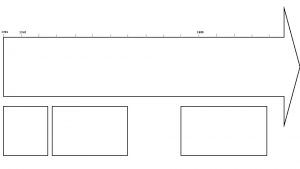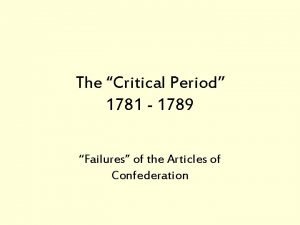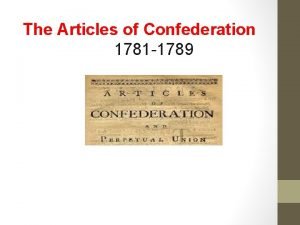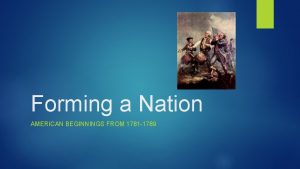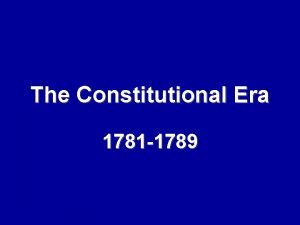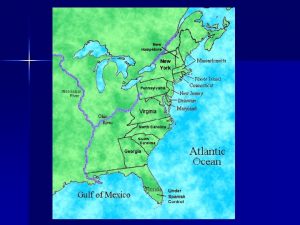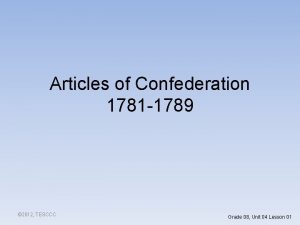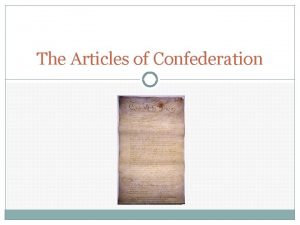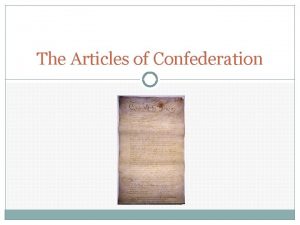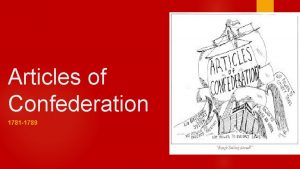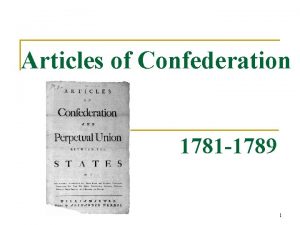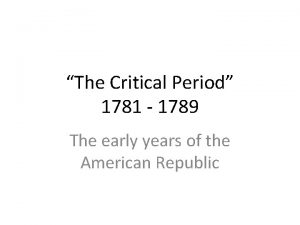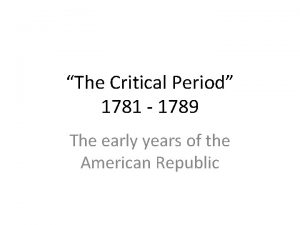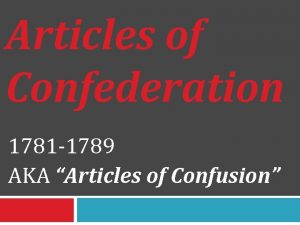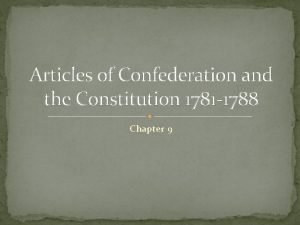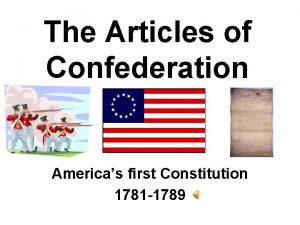Chapter 5 Creating the Constitution 1781 1789 A










































- Slides: 42

Chapter #5: “Creating the Constitution” (1781 – 1789)

A Confederation of States Early State Governments Main Idea: In 1776, each new state created a constitution and called for a republic, or government in which the people elect representatives. However, people thought differently about how to design a republic. Congress Creates the Articles of Confederation Main Idea: In 1777, the Continental Congress drafted the original constitution for the union of the states. This constitution was known as the Articles of Confederation. Congress Creates a Plan for Western Lands Main Idea: The national congress created plans for settling and governing the Northwest Territory. By selling this land to speculators and farmers, the Congress hoped to raise revenues and extend America’s republican society westward. Conflicts With Spain and Britain Main Idea: During the mid-1780 s, the Spanish and British did not take the new United States seriously. The Spanish forbade American trade with New Orleans, and Britain rejected Adam Smith’s new doctrine of free trade in favor of traditional mercantilism. Continued…

Section #1: “A Confederation of States” Where are we now? Where is the power? Republics – gov’ts where the people elect their representatives n But what is the best way to do this? w w Unicameral or bicameral Executive power or no Free religion Different voting rights

NOTE TAKING Reading Skill: Identify Main Ideas

Section #1: Cont. The Articles of Confederation (1777) n n n Limited National Gov’t – why? Met in Philadelphia, PA Written by John Dickinson w Based on Franklin’s “Albany Plan of Union” n n n One congress – unicameral Decisions approved by 9/13 Amendments – unanimous

Sect. #1: Opposition to the Articles of Confederation Many people knew having a Republic was hard! n How much power should ordinary citizens have? Problems with the Articles… n n n Couldn’t coin money or tax (could request money) Couldn’t form an army (could request soldiers) No Executive power (like a President) No central system (to interpret laws) Need a 9/13 majority to pass laws and unanimous vote to amend the Articles

QUICK STUDY Weaknesses of the Articles of Confederation

Initial Victories for the A. O. C. Settled and governed Northwest Territory (N of Ohio River and W of PA) n n Sell it for revenue!!! Having issues with settlers and Indians in this land. Land Ordinance of 1785 n Congress designed system of distributing the public lands. w $640/section (favored the wealthy)

How do we govern this land? Northwest Ordinance 1787 n n n Each territory had a gov, sec. , 3 judges, rights, etc. 5, 000 men – elect an assembly 60, 000 – statehood! w Must have republican constitution w Must ban slavery OH, IN, IL, MI, MN, WI

Section #1: Problems with the weak gov’t Did I mention trouble with the Indians in NW ordinance? Had trouble kicking GB off their old forts after the war…no army. Lost a trading partner b/c of the war. n GB and Canada Spain shut off the Mississippi River to our trade flow and would only re-open if we would say it belonged to them. n Gov’t can’t establish tariffs. Interstate trade was tough (bullies, currencies) n n Can’t regulate interstate trade, can’t coin money And then….

Shays’ Rebellion Massachusetts wouldn’t issue paper money to pay the war debt, so they levied taxes on land, which caused a depression. n Farmers were hit hard, why?

Shay’s Rebellion (cont. ) Mass sent people/farmers to debtors prison or they had to sell themselves into servitude. Many farmers saw foreclosure; they demanded change. Two months after the Massachusetts legislature meeting, where they had still refused to print paper money, farmers in three counties revolted. n They had pitchforks and farm tools. They took to the courts in attempts to close them. n Why? Because if the courts were closed, no farms would be foreclosed. Daniel Shays, revolutionary war hero, led this revolt!

Shay’s Rebellion (cont. ) After closing the court they tried for the federal arsenal. The gov’t sent 600 militiamen there. A few warning cannons were fired by the militiamen and the rebels scattered (Jan 1787). Most were caught and sentenced early on to death. Eventually sentences got lighter and then eventually let go. Judges said the rebels were driven by “restless, destructive”, feelings to overturn the gov’t. n Sam Adams called the farmers “wicked and unprincipled (dishonest) men. ”

Impact of Shay’s Rebellion Europe saw it as ridiculous. Thomas Jefferson said, “a little rebellion, now and then, is a good thing…the tree of liberty must be refreshed from time to time with the blood of patriots and tyrants. ” Made many more see why the Articles of Confederation Gov’t were weak. When Massachusetts asked for help to put down the rebellion, the Congress could not assist them. People called for a strong national government that could protect in time of crisis.

So, how do we fix this? 1786 – VA called for a national conference to discuss economic issues and possible revisions to the Articles of Confederation. n n Suggested to meet in Annapolis, MD because of the central location. Only five states came, no one from England, GA or Carolina, even Maryland didn’t come w They felt it was violating the authority of Congress Hamilton/Madison scolded states for not coming. n n They said send someone next time: Philly, May 1787 They said why it as important for people to come This letter is called the “Annapolis Address” and it was sent to the Confederation Congress and the governor of each state.

Sect. #1 cont.

Drafting the Constitution The Constitutional Convention Main Idea: Many Americans believe the Articles of Confederation needed revisions. Consequently, 12 of the 13 states sent delegates to a special convention in Philadelphia in May 1787. The delegates’ goal was to design a new and improved plan of government. Rival Plans of Government Main Idea: Before a constitution could be written and approved, the delegates needed to come to an agreement about what it should contain. To achieve this goal, they advanced and debated a number of proposals for several months, including the Virginia Plan and the New Jersey Plan. Settling Differences Through Compromise Main Idea: The delegates were far from a unanimous decision concerning a structure of a new government. The Great Compromise, which drew points from both the Virginia and New Jersey plans, outlined a potential solution.

https: //www. youtube. com/wat ch? v=uih. Nc_td. Gbk Constitutional Convention in 3 minutes.

Section #2: “Drafting the Constitution” Constitution = “Supreme Law of the Land!” Convention: n Philadelphia May 1787 w 12 states, 55 men – who? ? ? – Demi God’s n n Address the problems of the Articles. Father of the Constitution? Define: Amend A group of Virginians brought a plan of government to Philadelphia. What was the name of the plan?


Sect. #2 Cont. Virginia Plan n n n Edmund Randolph Bicameral Legislature. State representation was based upon population. Power to tax Power to regulate trade. Define: VETO Proposed executive and judicial branches New Jersey Plan n n n William Paterson Unicameral Legislature. One state – one vote concept. (Like Articles) Power to tax Power to regulate trade. National executive & judicial branches

Sect. #2 cont. The Great Compromise n n Solution to the two plans. Bicameral Legislature w Senate = 2 reps. Per state, equal representation. w House = reps. Based upon population. The Three-Fifths Compromise n n n Issue of slavery was a heated topic. Should slaves be counted as part of the population? Three fifths of a states slave population would be counted towards representation.


Sect. #2 cont.

System of Checks and Balances EXECUTIVE BRANCH LEGISLATIVE BRANCH JUDICIAL BRANCH *President *Congress *Supreme Court *Carries out laws. *Makes the laws. *Interprets the laws. Can veto acts of Congress. Can remove the Can declare acts of President from office. the President “unconstitutional”. Can appoint judges Can refuse to appoint Can declare acts of to the Supreme Court. judges. Congress “unconstitutional”.

Sect. #2 cont. Who was the first President of the United States of America? n How did he become President? Who was his Vice-President? How do you become a Representative? n A Senator? A Supreme Court Justice?



Ratifying the Constitution The Struggle Over Ratification Main Idea: Two groups quickly emerged in the debate over the Constitution: the Federalists who favored ratification of the Constitution and the Antifederalists who opposed it. Initially, the Federalists gained more support than the Antifederalists. Ratifying Conventions Main Idea: By mid-January of 1788, the Federalists had won ratification in five states. However, the Antifederalists mounted a strong fight in the remaining states whose support the Federalists sought. Principles of the New Constitution Main Idea: The Republic established by the Constitution of the United States became a symbol of freedom to countries around the world. Key principles of the Constitution included: popular sovereignty, limited government, separation of powers, federalism, checks and balances, and representative government. The Constitution Endures Main Idea: The Constitution is a relatively brief document, consisting of only 7, 000 words. Some politicians, like Thomas Jefferson, argued that it should be interpreted literally to restrict federal power. Most Federalists, including George Washington, insisted that the Constitution be read broadly to allow for the expansion of federal power when necessary. Continued…

Section #3: “Ratifying the Constitution” Ratify: To approve. What did it take to ratify the Constitution? Who are the Federalists, and why did they win? What are the “Bill of Rights”? When was the Constitution ratified?

Anti-Federalists vs. Federalists Anti-Federalists Concern: n n Constitution will give national govt. too much power. President will be just like a king. Individual liberties will be threatened by a powerful govt. Federal govt. could come under control of one powerful faction. Federalist Response: n n Constitution will give national govt. enough power to solve the country’s problems. System of checks and balances will limit President’s power. Bill of Rights will protect citizens’ freedom. Country is too big to be dominated by any one faction.


Quote from Elbridge Gerry: (one of the conventionists who didn’t sign!) “My principal objections to the plan are…that some of the powers of the legislature ambiguous, and others…dangerous; that the Executive…will have undue influence over the legislature; that the judicial department will be oppressive…and that the system is without the security of a bill of rights. ”


True test came to ratification…. The Constitution would go into effect as soon as 9 states ratified (not 13 like the articles). Each state had a special state convention, which gave ordinary citizens the opportunity to discuss and vote on whether the const should be ratified. December 1787 – Delaware, 1 st state, ratifies! After New Hampshire ratified in June 1788, in went into place in July. n Time to arrange for the first Presidential and Congressional elections.

What about those who didn’t ratify? Those in power knew that the gov’t would not succeed without VA (largest population at this time) and NY (important center for business and trade). Virginia: n n n Difficult b/c some of the most respected anti-feds were here (Patrick Henry). They feared the President would become a monarch. James Madison convinced them to ratify the constitution.

The Problem with New York: n n Wealthy landowners didn’t like b/c they thought they would have lots of taxes with the new system. John Jay and Alexander Hamilton said if the states didn’t ratify than N. Y. City would break away and join the new gov’t…so they caved. After NY and VA, North Carolina ratified in Nov. 1789, and Rhode Island did in May 1790.


Still a slight problem… Many states only ratified b/c they were told a bill of rights would come soon. Some federalists thought that a BOR was not necessary b/c people were promised those rights with the state constitutions. Also, some said the whole constitution was a big BOR document itself. Nevertheless, Madison pushed for a BOR.

The Bill of Rights Madison got over 200 suggestions for the BOR. n Would be the first amendments (official changes, corrections, or additions) to the Constitution. Sep 1789 Congress sent out a list of 12 amendments to the states to ratify, by Dec 10 had been ratified by the required ¾ majority. The BOR became the 1 st 10 amendments. n They added to the strength and flexibility of the Constitution. Established a clear example of how to amend a Constitution in the future to fit the needs of a changing nation.

https: //www. youtube. com/wat ch? v=o 9 Gs. Ifs 69 UY The Bill of Rights and other important amendments

Founding Fathers’ Fraternity https: //www. youtube. com/watch? v=k 8 i R 8 z. C 7 p. WE
 Creating the constitution answer key chapter 2 section 4
Creating the constitution answer key chapter 2 section 4 Chapter 2 lesson 4 creating the constitution
Chapter 2 lesson 4 creating the constitution Tci chapter 6 answers
Tci chapter 6 answers Chapter 8 creating the constitution
Chapter 8 creating the constitution Uranus was discovered accidentally in 1781
Uranus was discovered accidentally in 1781 Bolzano (1781 – 1848)
Bolzano (1781 – 1848) Creating the constitution vocabulary
Creating the constitution vocabulary Texas constitution vs us constitution
Texas constitution vs us constitution Nc constitution vs us constitution
Nc constitution vs us constitution Constitution what is constitution
Constitution what is constitution The constitution lesson 1 principles of the constitution
The constitution lesson 1 principles of the constitution The tennis court oath
The tennis court oath Source analysis
Source analysis Europe in 1789
Europe in 1789 1789 apush
1789 apush French revolution symbols
French revolution symbols The chimney sweeper songs of experience
The chimney sweeper songs of experience Bolton romanticism amp; politics 1789 1832 download
Bolton romanticism amp; politics 1789 1832 download Frise républiques françaises
Frise républiques françaises Napoleon 1789
Napoleon 1789 Sistema internacional clasico
Sistema internacional clasico Europa en 1789
Europa en 1789 Immediate cause of french revolution
Immediate cause of french revolution Linea historica
Linea historica May 1789 french revolution
May 1789 french revolution Write the causes of french revolution
Write the causes of french revolution The divisions in spanish colonial society 1789
The divisions in spanish colonial society 1789 1797 - 1789
1797 - 1789 July 14 1789
July 14 1789 1789 france
1789 france Against the gods 1789
Against the gods 1789 Art 1789
Art 1789 1789
1789 Chapter 18 creating competitive advantage
Chapter 18 creating competitive advantage Competitor centered company
Competitor centered company Chapter 18 creating competitive advantage
Chapter 18 creating competitive advantage Chapter 6 creating a nation
Chapter 6 creating a nation Chapter 6 creating a nation
Chapter 6 creating a nation Chapter 18 creating competitive advantage
Chapter 18 creating competitive advantage Chapter 8 lesson 1 principles of the constitution answers
Chapter 8 lesson 1 principles of the constitution answers Ratifying the constitution chapter 5 section 3
Ratifying the constitution chapter 5 section 3 Chapter 5 section 2 drafting the constitution
Chapter 5 section 2 drafting the constitution Chapter 7 lesson 2 forging a new constitution
Chapter 7 lesson 2 forging a new constitution
